
The Avro Lancaster, commonly known as the Lancaster Bomber, is a British Second World War heavy bomber. It was designed and manufactured by Avro as a contemporary of the Handley Page Halifax, both bombers having been developed to the same specification, as well as the Short Stirling, all three aircraft being four-engined heavy bombers adopted by the Royal Air Force (RAF) during the same era.
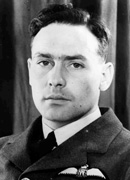
John Dering Nettleton, VC was a South African officer in the Royal Air Force (RAF) during the Second World War. He is most famous for leading the Augsburg raid, a daylight attack against the MAN U-boat engine plant in Augsburg on 17 April 1942. For his role in this mission he was awarded the Victoria Cross, the highest award for gallantry in the face of the enemy that can be awarded to British and Commonwealth forces.
The Pathfinders were target-marking squadrons in RAF Bomber Command during World War II. They located and marked targets with flares, at which a main bomber force could aim, increasing the accuracy of their bombing. The Pathfinders were normally the first to receive new blind-bombing aids such as Gee, Oboe and the H2S radar.
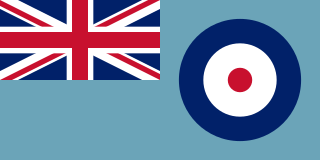
No. 5 Group RAF was a Royal Air Force bomber group of the Second World War, led during the latter part by AVM Sir Ralph Cochrane.

The bombing of Augsburg in World War II included two British RAF and one USAAF bombing raids against the German city of Augsburg on 17 April 1942 and 25/26 February 1944.

Operation Bellicose was an attack by Avro Lancaster bombers of the Royal Air Force on a German radar factory housed in the former Zeppelin Works at Friedrichshafen and the Italian naval base at La Spezia. It was the first shuttle bombing raid in the Second World War and the second use of a Master Bomber. In early June 1943, a Central Interpretation Unit photo interpreter identified a stack of ribbed baskets at the Zeppelin Works. After Winston Churchill viewed the photos at RAF Medmenham on 14 June, No. 5 Group RAF received the surprise orders on 16 June to attack Friedrichshafen during the next full moon.
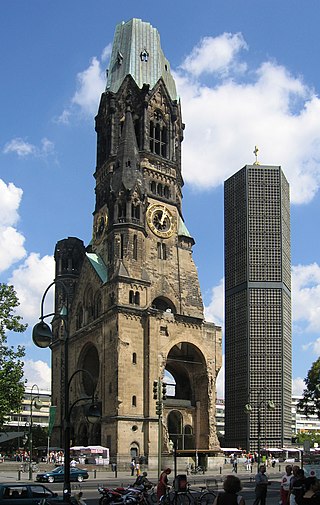
The Battle of Berlin was a bombing campaign against Berlin by RAF Bomber Command along with raids on other German cities to keep German defences dispersed. Air Chief Marshal Sir Arthur Harris, Air Officer Commanding-in-Chief (AOC-in-C) Bomber Command, believed that "We can wreck Berlin from end to end if the USAAF come in with us. It will cost us between 400 and 500 aircraft. It will cost Germany the war".

Operation Hydra was an attack by RAF Bomber Command on a German scientific research centre at Peenemünde on the night of 17/18 August 1943. Group Captain John Searby, commanding officer of No. 83 Squadron RAF, commanded the operation, the first time that Bomber Command used a master bomber to direct the attack of the main force. Hydra was the first operation against the German V-weapon programme, a campaign later known as "Crossbow". The British lost 40 bombers and 215 aircrew, and several hundred enslaved workers in the nearby Trassenheide forced labour camp were killed. The Luftwaffe lost twelve night-fighters and about 170 German civilian personnel were killed, including two V-2 rocket scientists. Assessments of the raids effectiveness vary; the United States Strategic Bombing Survey (1945) called the raid "not effective", while in 2006 the historian Adam Tooze judged that it had been highly successful.
No. 61 Squadron was a squadron of the Royal Air Force. It was first formed as a fighter squadron of the British Royal Flying Corps during the First World War. It was reformed in 1937 as a bomber squadron of the Royal Air Force and served in the Second World War and after, until disbanded in 1958.

No. 463 Squadron RAAF was a Royal Australian Air Force heavy bomber squadron during World War II. The squadron was formed in the United Kingdom in late 1943 from personnel and aircraft allocated from No. 467 Squadron RAAF. The squadron was equipped with Avro Lancaster bombers and flew its first raids on Germany immediately after being formed. Operating as part of RAF Bomber Command No. 463 Squadron conducted raids against cities, industrial facilities and military targets in Germany, France and Norway throughout 1944 and until the end of the war in May 1945. Following the war, the squadron evacuated Allied prisoners of war from Europe until it was disbanded in late 1945.
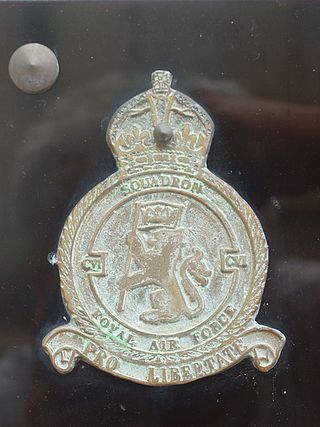
No. 106 Squadron RAF was a Royal Flying Corps and Royal Air Force squadron active from 1917 until 1919, throughout World War II and during the Cold War from 1959 until 1963.
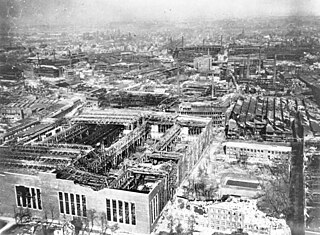
The Battle of the Ruhr was a strategic bombing campaign against the Ruhr Area in Nazi Germany carried out by RAF Bomber Command during the Second World War. The Ruhr was the main centre of German heavy industry with coke plants, steelworks, armaments factories and ten synthetic oil plants. The British attacked 26 targets identified in the Combined Bomber Offensive. Targets included the Krupp armament works (Essen), the Nordstern synthetic oil plant at Gelsenkirchen and the Rheinmetall–Borsig plant in Düsseldorf, which was evacuated during the battle. The battle included cities such as Cologne not in the Ruhr proper but which were in the larger Rhine-Ruhr region and considered part of the Ruhr industrial complex. Some targets were not sites of heavy industry but part of the production and movement of materiel.
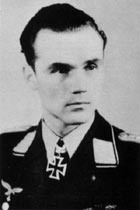
Gerhard Ferdinand Otto Raht was a German Luftwaffe military aviator during World War II, a night fighter ace credited with 58 aerial victories claimed in 171 combat missions making him the tenth most successful night fighter pilot in the history of aerial warfare. All of his victories were claimed over the Western Front in Defense of the Reich missions against the Royal Air Force's (RAF) Bomber Command.

Georg-Hermann Greiner was a Luftwaffe night fighter ace who served during World War II. Greiner was recipient of the Knight's Cross of the Iron Cross with Oak Leaves—the fourth highest German award by war's end. He was also a squadron commander in the prestigious Nachtjagdgeschwader 1, the most successful night fighter interceptor unit of any nation in the history of aerial warfare.
Ernst-Georg Drünkler was a German Luftwaffe military aviator during World War II, a night fighter ace credited with 47 aerial victories, including two by day, claimed in 102 combat missions making him the thirtieth most successful night fighter pilot in the history of aerial warfare. The majority of his victories were claimed over the Western Front in Defense of the Reich missions against the Royal Air Force's Bomber Command.

The aircrews of RAF Bomber Command during World War II operated a fleet of bomber aircraft carried strategic bombing operations from September 1939 to May 1945, on behalf of the Allied powers. The crews were men from the United Kingdom, other Commonwealth countries, and occupied Europe, especially Poland, France, Czechoslovakia and Norway, as well as other foreign volunteers. While the majority of Bomber Command personnel were members of the RAF, many belonged to other air forces – especially the Royal Canadian Air Force (RCAF), Royal Australian Air Force (RAAF) and Royal New Zealand Air Force (RNZAF). Under Article XV of the 1939 Air Training Agreement, squadrons belonging officially to the RCAF, RAAF, and RNZAF were formed, equipped and financed by the RAF, for service in Europe. While it was intended that RCAF, RAAF, and RNZAF personnel would serve only with their respective "Article XV squadrons", in practice many were posted to units of the RAF or other air forces. Likewise many RAF personnel served in Article XV squadrons.

The Augsburg Raid, also referred to as Operation Margin, was a bombing raid made by the RAF on the MAN U-boat engine plant in Augsburg undertaken during the daylight hours of 17 April 1942. The mission was assigned to No. 44 (Rhodesia) Squadron and No. 97 Squadron, both of which were equipped with the new Avro Lancaster. The speed of the Lancaster and its large bombload capacity gave reason for optimism that the raid might succeed. It was the first of the attacks upon German industry in Augsburg.

Patrick Arthur Dorehill, was an officer in the Royal Air Force. A bomber pilot, he flew as flight engineer for John Nettleton during the Augsburg raid, where they carried out a daring daylight attack against the MAN U-boat engine plant at Augsburg in southern Germany, earning him an immediate DFC and his captain the Victoria Cross. He completed two full combat tours as a bomber pilot. With his commitment to combat flying completed, he was transferred to the BOAC where he flew transports. Following the war Dorehill had a lengthy career as a commercial airline pilot.

Operation Oyster was a bombing raid made by the Royal Air Force (RAF) on 6 December 1942 upon the Philips works at Eindhoven, Netherlands. The Philips company was a major producer of electronics equipment, including vacuum tubes for radio communication. Prior to the Battle of the Netherlands in 1940, Philips was known to be a leading research firm in infrared and radar technology. To ensure accuracy and minimise casualties among the Dutch citizens, the raid had to be undertaken during the day.

The Bombardment of Mailly-le-Camp was an RAF raid against a German panzer training center located in northern France undertaken during the night of 3/4 May 1944. The mission was a part of the "softening up" campaign Bomber Command conducted prior to the D-Day invasion. The operation was assigned to No. 5 Group, which was joined by No. 1 Group. Estimated a lightly defended target, confusion in the mission plan and communication problems led to the force being held up at the assembly point, where German night fighters slipped in among the bombers. Though the bombers succeeded in destroying the training camp, the victory was achieved at a heavy price.




















